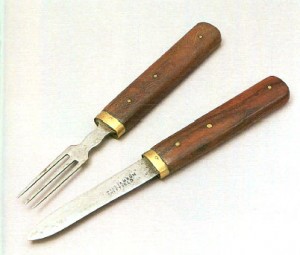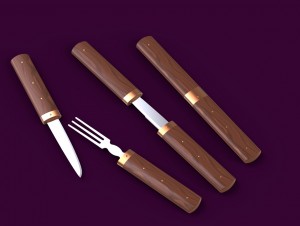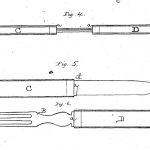We may receive a commission when you use our affiliate links. However, this does not impact our recommendations.
When I hang out with other woodworkers, the conversation almost always turns to what we are building now and what we are building next. Recently I said something I didn’t think I’d ever say:
“I want to build a fork.”
As I’ve been digging deeper into the 250-year history of campaign furniture, I’m turning up projects that are cool and unusual – not your typical bookcase, birdhouse or whirligig. A couple months ago I found an awesome fork and knife set that were illustrated in Nicholas A. Brawer’s “British Campaign Furniture: Elegance Under Canvas” (Abrams). Tip: If you want to read the book, get it from your library – it’s crazy expensive.
This might just be the coolest fork and knife set I’ve ever seen. The mahogany handles are riveted to the metal tangs of the fork and knife. But what is crazy is that the fork and knife slide together to make a compact traveling set.
I am so enthusiastic about building these that I’ve been soliciting help from readers who have metal skills. After some CAD work, reader William Heidt came up with construction drawings and this 3D render.
And now we are talking about getting someone to cut out the metal using laser or water-jet. Stay tuned here. If we find someone who will cut them for us we will let you know.
After years of building stuff, finding a new sort of project that you’ve never encountered is startling and energizing – like finding a room in your house that you never knew existed. It also reminds me how myopic I can be. It’s easy to get focused on typical woodworking projects.
There’s nothing wrong with that because we all need bookcases. But if you look around a little more you might find things that will inspire you to acquire new skills. For example: Making treenware for our house has been the real motivator in learning to turn. Some of Robin Wood’s beautiful spoons and bowls have made me want to carve.
Remember: At one time, almost everything in the house was made of wood. Spoons, cups, bowls, platters, even shoes.
So there’s no reason that could not be true again.
— Christopher Schwarz
If you are interested in the history of wooden objects, a good (non-academic) place to start is with Eric Sloane’s books. “A Reverence for Wood” is a book I think every woodworker would enjoy – and you can usually find it for $2 used. Check AbeBooks.com and you’ll find tons of copies available.
Here are some supplies and tools we find essential in our everyday work around the shop. We may receive a commission from sales referred by our links; however, we have carefully selected these products for their usefulness and quality.












Is there any way I could get the plans for this amazing tool? I am asking someone to make one for me and he is not 100% sure he can do it. I told him I would try to find plans for it and he said that would let him know if he could do it or not. I looked for the book at my local library and they don’t have it. Looked for pdfs on the net and couldn’t find them. Kind of at the end of the road. Any and all help would be great. Please contact me via email. derekbrow@gmail.com
Laser, waterjet or even plasma cutting of metal can be an expensive proposition, but also perhaps a bit at odds with the handcrafted nature of the project overall.
One can cut thin annealed sheet steel (at least up to 16 gauge) fairly easy with a jeweler’s saw and clean it up quite nicely with files. I’ve even cut up to 1/8″ O1 tool steel this way when making tools. You might be able to find a local artisan, jeweler, metalsmith or blacksmith that might be willing to do the work cheaper than an industrial job.
Coming from a traditional metalsmithing background focused on the use of hand tools to working wood with power tools was challenging, but having recently discovered the joys of hand tools has not only increased my pleasure in wood working, but improved my skills significantly. Realizing that working wood with hand tools was more rewarding I was reminded how the same was true of working metal.
Here is the modern version:
http://www.hardwaresphere.com/2011/05/24/swiss-advance-retractable-fork-and-knife/
I completely relate to your enthusiasm for new sorts of projects and where they can take you.
Wanting to build chairs, led me to the lathe, and I didn’t stop at spindle turning. I love to make bowls now.
Recently I decided to make a backgammon set, and it has led me to leather work for the playing surface, marquetry for the outside panels of the case, and some new lathe boring techniques for the checker trays among other things. The marquetry especially has been the door to whole new world of possibilities.
For more chairs, I have my sights on steam bending next, and have begun to gather the equipment. All the new stuff just keeps expanding my world of possibilities. It’s uniquely rewarding. Too many woodworking magazines are far too crabbed in their article selection – sticking to the bookcases as you say. The old FWW wasn’t like that, and I think they were much stronger for it.
I recall having a knife and fork like this in my boy scout youth days. It was made of plastic and the fork had a slot in it near the handle to open bottle caps. They were commonly available at camping goods stores. Fifty years ago.
Somehow the thought of storing knife and fork in closed pockets gives me worries about proper sanitation. Like @bko, I spent time in the Boy Scouts, in the era of nesting steel spoon, fork, and knife. Failure to keep these clean (boiling water rinse) could have, um, memorable results.
Now, I’m perfectly comfortable with the the “10 second rule” for food that falls on the floor. (Or ground.) But the thought of putting eating tools into a closed (and perhaps moist) wooden space gives me the willies. Kinda hard to keep those pockets clean, doncha think?
I am a professional cook and I carved measuring spoons out of jewel tree several years ago and have loved having wooden cooking tools instead of the thin metal measuring spoons we all use. So, worth the effort. On a completely different note – I recently purchased Chris’s book on building workbenches. I live in Minneapolis, Minnesota and can not find Yellow Southern Pine, or anything relatively inexpensive that isn’t riddled with knots. Any suggestions other than Poplar, which is still too expensive for me.
Either laser or water jet or high definition plasma would all work for this. You’re probably looking at material about 1/8″ thick, any of the stainless alloys used in knife making would do great (ATS-34, 440C), although heat treating stainless is a specialist operation. You could make them from a non-stainless alloy and harden/temper them with a torch but then you’be got to be careful with cleaning so they don’t rust.
But if you just want top make a set for your self this is easy to do without CNC cutting. Print out the drawings full size and spray-glue them to the metal stock. Snap punch the holes and a few key locations on the layout. Hacksaw and file to shape. Clean up with sandpaper, drill your holes and you’re done. If you use a non-stainless steel like L6 it’s easy to harden/temper and has enough chromium to resist rusting with a little care.
-Joe
A laser cutter might be better for thin gauge used on a knife or fork. What I’ve seen cut on a water jet has all been thicker than 1/4″. I’m thinking it might distort the shape on thin sheet.
titanium would be nice, if not period, but then neither are lasers. plasma cutting might be OK too, but more prone to splatter I’d think than a properly set laser.
the knife blade in the CAD 3D rendering doesn’t have the same profile as the old one (I like the old one better). looks too much like a modern steak knife.
If you can’t find a reader with his own laser cutter, this publication may be of help in locating a source
http://www.ffjournal.net/
3M products might be able to help you locate some laser cutters too – they would probably know who they sell laser tape to in your area – there are a few I found in a quick web search. the tape/film is mostly to protect the metal surface against damage from handling, not the laser or splatter.
I regret not taking the Flatware Design course in college with esteemed metalsmith Peter Pripp. It is a fascinating genre of design. For every nice looking set of flatware there is twice as many badly conceived, ridiculously non-practical, and non ergonomic sets.
This is a perfect thing to get 3-d printed in order to test the ergonomics. It is cheaper and more accessible than you think. The results are invaluable too. Send your cad models out and a few days later you will be holding your design in your hand.
Flatware design is like chair design. Anybody can use it and instantly say whether it is comfortable or not.
A perfect utilization of the knew concepts saw that you bought for doing dovetails.
Remember, it was designed for cutting metal first.
Use a “bench pin” (what you guys call a “birds mouth”), get some metal cutting blades (I would suggest a #3 as you are not cutting precious metals), sit down and relax.
You might need to use an optivisor as you will be doing some fine detail work, but I am sure that your skills are more than enough to do this.
Besides, while water jet is an excellent method, it seems such a sledge hammer approach to solve an exquisite need. Also, the water jet cut vertical line left by the cutting action will not be truly vertical, but will have a slight “draft” that would have to be filed or sanded to clean everything up to your standards.
Depending upon how far that you want to go, you could cut a contour shape crosswise into a nice block of hardwood, creating a punch and anvil that could be used to form the bent shape of the fork and spoon.
Just a thought.
Lee (the saw guy)
While there is no doubt that waterjets are cool, I have two prototyping suggestions for you:
1. Buy a couple of hors d’oeuvre or fondue forks from Craft Supplies and try them out.
2. Buy a “hobo knife” and take it apart. Here’s one from Ka-Bar on Amazon for small money:
http://www.amazon.com/Ka-bar-KNIFE-HOBO-STAINLESS-FORK-SPOON/dp/B000JMF054/ref=sr_1_3?ie=UTF8&qid=1327152944&sr=8-3
The hobo knife fork looks perfect for your application.
Just as an aside, I do a lot of camping with my son’s Scout Troop and I find a “spork” and/or chopsticks to be the most practical way to eat in the field.
Very interesting, and you weren’t kidding about the book. yeesh.
There were a lot of silver or brass knives and forks for campaigning items and those can be made right in your own workshop with a torch for annealing and a jewelers saw to cut the shape plus filing for finish work.
A lot of campaign items were crafted in India and they often used brass as the metal of choice.
It just does not seem right to handcraft this item and then stick a laser cut piece of metal into the handle.
“Brawer’s “British Campaign Furniture: Elegance Under Canvas” (Abrams). Tip: If you want to read the book, get it from your library – it’s crazy expensive.”
Eh, so what’s $350-$3,307.07 between friends?
Uh, no I’m not offering to buy you copy, but you can still be my friend.
http://www.amazon.com/gp/offer-listing/0810957116/ref=dp_olp_used?ie=UTF8&qid=1327118211&sr=1-1&condition=used
This would be a cool project. Make sure they waterjet enough parts for everyone. It will be 2012’s version of pen turning.
“Remember: At one time, almost everything in the house was made of wood.”
If this is no longer true, I’ve heard they now make a pill that helps.